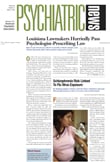Certainly genes play a causative role in schizophrenia, but new research provides more evidence that family environment can influence a genetic susceptibility to the illness.
Pekka Tienari, M.D., professor emeritus of psychiatry at the University of Oulu, Finland; Lyman Wynne, M.D., Ph.D., professor emeritus at the University of Rochester; and other psychiatric researchers at the University of Oulu studied the issue.
As they reported in the March British Journal of Psychiatry, it looks as though family environment can have some influence on whether a child with a genetic risk for schizophrenia develops the illness.
If a child with a genetic risk for schizophrenia grows up in a dysfunctional family, it may tip the scales toward developing the disorder, but if the child grows up in a well-functioning family, it may possibly keep him or her from developing the illness.
Tienari and his colleagues reviewed the hospital records of some 19,000 women who had been in Finnish psychiatric hospitals between 1960 and 1979. After they had identified the women with schizophrenia, they examined census data and parish registers in Finland to find out which of those women had given birth to a child that she put up for adoption.
A total of 145 of those offspring were identified and then matched with 158 offspring who had been adopted but had not come from mothers with schizophrenia.
Psychiatrists then visited the adoptees and their adoptive families at home over a two-day period. This was when the adoptees were, on average, 23 years of age. The psychiatrists interviewed all individual family members, then the parents, and then all family members together. The psychiatrists also observed how members in each family interacted with each other.
Interview results and clinical observations were then used to rate how well each family functioned via a 33-item Finnish-language instrument called the Oulu Family Rating Scale. The scale had been developed for clinical evaluation of family relationships during interviews and observations in the family home. The scales assessed such factors as criticism, parent-parent conflict, lack of empathy, parent-offspring conflict, inflexibility, constricted communication, and lack of humor. Families were rated at five levels, from “healthy” to “severely dysfunctional.”
The adoptees were also interviewed when they were on average 23 years of age to determine whether they had schizophrenia or schizophrenia-spectrum disorders. They were re-evaluated 12 years later.
Forty of the 303 adoptees (13 percent) were found to have schizophrenia or a schizophrenia-spectrum disorder. Of the 40, 32 came from a high-genetic-risk background.
The researchers then attempted to determine whether there were any relationships between family dysfunction and adoptees developing a schizophrenia-type disorder. They found that there was a significant link between being reared in a dysfunctional family and developing a schizophrenia disorder in the adoptees whose mothers had had schizophrenia. In contrast, no link could be found between being reared in a dysfunctional family and developing a schizophrenia disorder in adoptees whose mothers had not had schizophrenia.
These results, the researchers noted in their study report, “can be interpreted as an example of genotype-environment interaction; that is, adoptees at genetic risk are more sensitive to problems in the adoptive family. . . . An alternative way to view the findings is that there appears to be a protective effect in having been reared in a ‘healthy’ adoptive family. . . . High-genetic-risk adoptees reared in families with low Oulu Family Rating Scale ratings had significantly fewer schizophrenia-spectrum outcomes than high-genetic-risk adoptees reared in families with high Oulu Family Rating Scale ratings.”
Another interesting implication of their findings, the researchers said, is that “there is no specific, sharply delimited form of environmental problem and that the biological and psychosocial environment has multiple components, perhaps like multifactorial genetics.”
Their findings are also striking, they added, in “that neither high-genetic-risk nor dysfunctional family environment alone predicted adoptee illness. This can be interpreted as meaning that genetic risk and the rearing environment have an interactive effect, both in promoting the emergence of illness and protecting against such an outcome.”
All in all, Wynne told Psychiatric News, the study’s findings challenge the concept that genetic risk in schizophrenia is destiny, and they mesh with some current efforts to prevent schizophrenia (Psychiatric News, November 15, 2002).
The researchers noted some of their study’s limitations. For instance, parents who had adopted children with a high genetic risk for schizophrenia might have interacted with them in a less favorable way than if they had adopted youngsters without such a risk simply because the former might have shown some early signs of the illness. If such is the case, then such interaction might have skewed study results.
The study was funded by the National Institute of Mental Health, the Scottish Rite Schizophrenia Research Programme, the National Research Board in Finland, and the Signe och Ane Gyllenberg Foundation.
The British Journal of Psychiatry 2004 184 216
